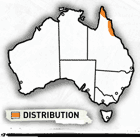The Southern Cassowary (Casuarius casuarius) belongs to an ancient group of flightless birds called ratites, along with the Australian emu, African ostrich and New Zealand kiwi. Found in the dense, tropical rainforests of north-east Queensland, the Southern Cassowary is Australia’s heaviest flightless bird. (Note: although it lives in Australia’s north, this bird is named the Southern Cassowary because it lives south of major cassowary populations in New Guinea.)
Description:
The Southern Cassowary stands about 1.8m tall and weighs around 60kg – 70kg. The large, greyish helmet (casque) makes it easily identifiable. The function of the casque is poorly understood, but it is claimed to act as a kind of crash helmet for bashing through undergrowth. The body is covered in black, hair-like feathers. The bare skin of the head and fore-neck is blue, while the rear of the neck is red. Both sexes are similar in appearance, but females are generally larger than males, they have taller casques and are brighter in colour. Cassowaries have heavy, well-muscled legs. Each leg has three toes, with a big, dagger-shaped claw on the inside toe that can be used in defence. When the bird is cornered or protecting chicks, it kicks out with both feet at once, and can severely injure animals and humans. It reaches 40 kilometres per hour in short sprints.
Southern Cassowaries normally feed alone. Their diet consists mainly of fruit, but they will also eat anything from fungi, snails and flowers to small dead mammals. The cassowary has an important role as a rainforest gardener, swallowing fruit and then excreting the seeds about a kilometre away, along with a pile of dung. When the seeds germinate they have their own supply of fertiliser to help them grow.
The calls of the Southern Cassowary consist of an assortment of rumblings and grunts. If a cassowary is approached it will generally stand its ground. If the intruder gets too close, the bird will stretch itself to its full height, ruffle its feathers and hiss loudly to scare off the intruder. If two males should meet, they have a stand off where both birds stand tall, fluff up their feathers and rumble at each other until one retreats. If a male and female meet, the male will move away, as the female is dominant.
Breeding:
Between June and August, the male builds a flat dish of leaves, grass and sticks on the forest floor, using the same nesting site over many years. Into this nest, the female lays from three to five glossy green eggs. She then moves away, leaving the male in charge of the incubation.
The male sits on the eggs for about 50 days. Even though the chicks can walk and feed themselves soon after hatching, the male protects them for nine months or more. During the breeding season, these parental males are very aggressive, and attacks on humans have been recorded at this time. Cassowary chicks mature at around three years old, and can live as long as 40 years.
Endangered species:
It is estimated that there are around 2000 Southern Cassowaries left in the wild. Their numbers are decreasing due to road kills, dog attacks, widespread clearing and fragmentation of rainforest habitat.



